The Great Depression & WW II
War Industries
Tennessee companies made many important products for the U.S. military during World War II.
Businesses in Tennessee received more than one billion dollars in contracts for military supplies from 1940 to 1945. Although Tennessee industries did not experience as much growth as in some other parts of the nation, war production provided the state economy with a much needed boost.
In Memphis, major companies changed their product lines to meet wartime demand. At the Firestone plant, workers accustomed to making car tires changed to producing life rafts and tires for military vehicles.
During much of the war, the Ford plant in Memphis produced parts for airplanes instead of cars. Other Memphis firms provided products like chemicals, explosive shells, and medicines.
Tennessee played an important role in producing weapons. The massive Holston Ordnance Works plant was located near Kingsport. In this factory, workers produced a very dangerous explosive called Research Development Explosive or RDX.
The Milan Ordnance Center in West Tennessee employed around 11,000 people who produced a variety of shell ammunition, boosters, and fuses, and operated an ammonium nitrate plant.
A secret city in East Tennessee, Oak Ridge, produced material for nuclear bombs. Most Tennesseans didn't know it existed until after the atomic bombs were dropped on Japan in 1945.
During the war, Nashville became an important center for military aircraft production. In 1940, a new, very large airplane factory was constructed in Nashville. During the war, Vultee made planes for both Great Britain and the United States. They built both fighter and bomber airplanes.
Vultee received orders for more than $142 million worth of planes during the war. This business also quickly made them the largest industrial employer in Middle Tennessee, as employment climbed from 900 in 1941 to more than 7,000 in 1943.
Picture Credits:
- A maintenance man at the Combustion Engineering Company in Chattanooga makes adjustments to pipes in June 1942. The company is described as having the largest cold steel hydraulic press in the world. U.S. Office of War Information photograph now at the Library of Congress
- A woman worker at Vultee in Nashville operates a hand drill while working on a stabilizer for a dive bomber. U.S. Office of War Information photograph now at the Library of Congress
- These three welders are working on a boiler for a ship. The photograph was taken in 1942 at Combustion Engineering Company in Chattanooga. U.S. Office of War Information photograph now at the Library of Congress
- A worker tightens a nut of a seramotor in TVA's hydroelectric plant at Watts Bar Dam in Tennessee in 1942. U.S. Office of War Information photograph now at the Library of Congress
-
Workers at Bemis Brothers Bag Company stand around a World War II poster at the cotton mills. The poster says "Take Care! Idle hands work for Hitler." The poster has a photograph of a man with his arm in a sling. Bemis Collection, Union University, Volunteer Voices, Digital Library, University of Tennessee Knoxville
- Two parachute riggers repack a parachute at the Naval Air Station in Memphis, around 1943. U.S. Navy photograph now at the National Archives
-
Workers at the Williams Steel Works in Jackson, Tennessee, weld submarine net floats during World War II. Jackson Business History Project Collection, Jackson-Madison County Library, Volunteer Voices, University of Tennessee Knoxville
The Great Depression & WW II >> World War II >> Working for the War >> War Industries
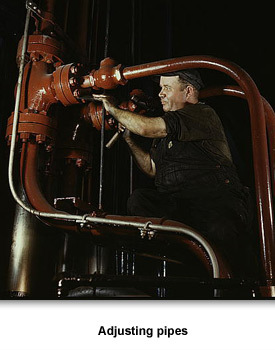
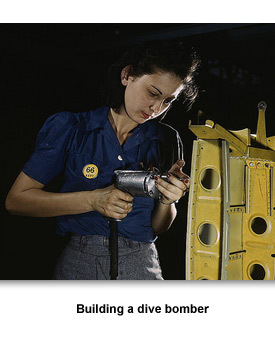
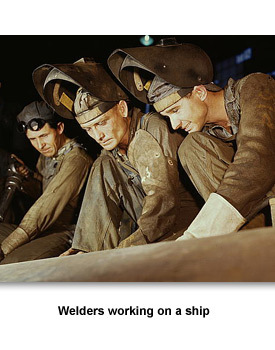
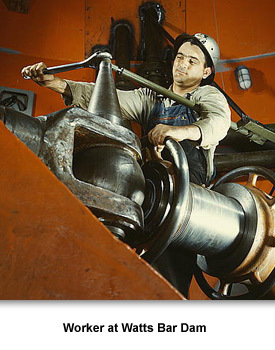
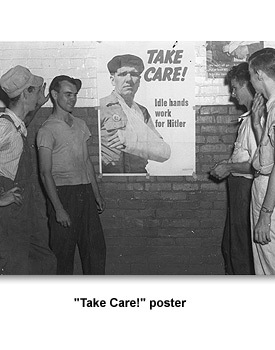
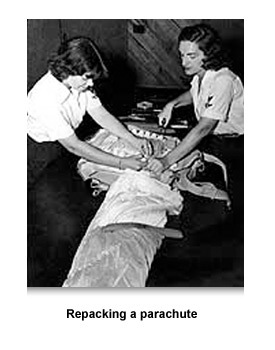
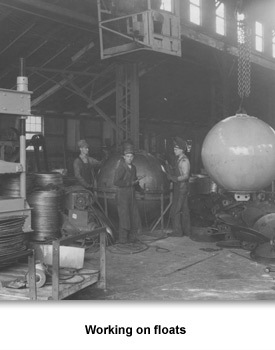
 Sponsored by: National Endowment for the Humanities
Sponsored by: National Endowment for the Humanities